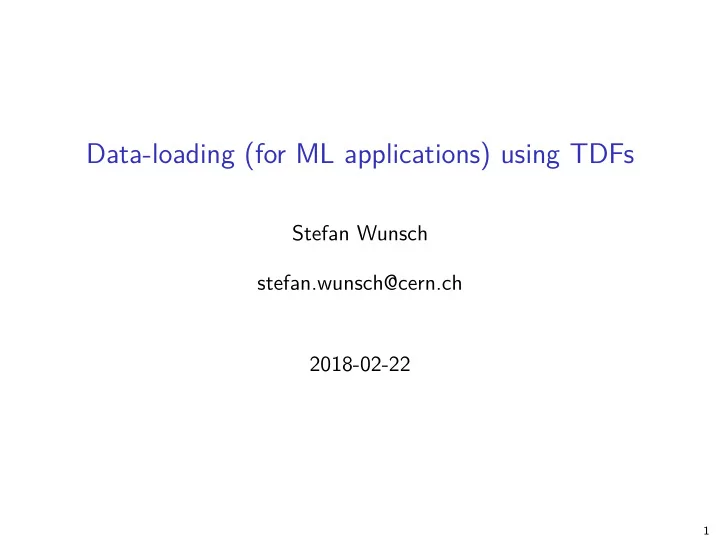

Data-loading (for ML applications) using TDFs Stefan Wunsch stefan.wunsch@cern.ch 2018-02-22 1
Motivation ◮ Most of the data analysis of the high-level HEP analyses happens in the Python domain (frameworks of analysis groups on top of flat ntuples). ◮ Even more extrem for ML applications: Most frameworks are only usable from Python (Keras, xgboost, most of TensorFlow, PyTorch, . . . ) ◮ How data-loading often looks like (for ML applications) in HEP: ... >>> x = root_pandas.read_root("file.root", "tree").as_matrix() >>> print(x.shape) (number_of_entries, number_of_branches) >>> model.fit(x, ...) ... ◮ Most efficient solution today: root_numpy (used by root_pandas ) ◮ But ROOT has the possibilities to do this more efficient. 2
Random slide from a MVA-based analysis 3
Feature request ◮ Support taking data from ROOT files and put it into memory (as fast as possible) ◮ Memory layout of the output: Contiguous, interpretable as n-dimensional arrays ◮ Make the data accessible from Python, interpretation of memory as numpy array Interface proposal using TDataFrame : >>> tdf = ROOT.Experimental.TDataFrame("tree", "file.root") >>> tdf = tdf.Filter("var1>0").Define("new_var", "var1*var2") >>> x = tdf.AsMatrix(["var1", "var2", "new_var"]) >>> print(x.shape) (number_of_entries, 3) 4
Advantages compared to root_numpy approach ◮ Useful set of TDF features directly usable ◮ Efficient selection of data ( Filter ) ◮ Define new variables ( Define ) ◮ Other fancy operations ( ForEach ) ◮ . . . ◮ Size of input files not limited by memory ◮ Make use of implicit multi-threading → Gain of a factor of N in speedup (ideally) 5
First benchmarks (1) Loading 709MB of data from disk to memory. Array of random floats with shape (50000000, 4) 12 Elapsed time in seconds 11 10 root_numpy TDataFrame 9 8 7 1 2 3 4 Number of threads Measured on a machine with (2) 4 (physical) logical cores. 6
First benchmarks (2) Performance subject to input data size and number of threads 50 TDF with 1 thread TDF with 2 threads Elapsed time in seconds TDF with 3 threads 40 TDF with 4 threads root_numpy 30 20 10 0.7 1.4 2.1 2.8 Size of data in MB Measured on a machine with (2) 4 (physical) logical cores. 7
First benchmarks (3) Loading 2.8GB of data from disk to memory. 60 Elapsed time in seconds 50 40 30 20 0 5 10 15 20 Number of threads Measured on a machine with (24) 48 (physical) logical cores. 8
What is missing to do this properly? ◮ Proposal for a matching interface in C++ (Container for returned data?) ◮ Proper PyROOT handling of numpy arrays ◮ Input argument handling: Interpreted as float* , shape information is lost ◮ Return value handling: Not supported (?) 9
Recommend
More recommend